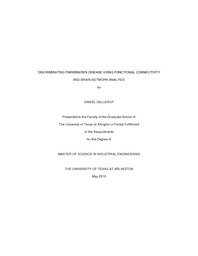| dc.contributor.advisor | Wang, Shouyi | |
| dc.contributor.advisor | LeBoulluec, Aera Kim | |
| dc.creator | Gellerup, Daniel | |
| dc.date.accessioned | 2016-07-08T20:35:31Z | |
| dc.date.available | 2016-07-08T20:35:31Z | |
| dc.date.created | 2016-05 | |
| dc.date.issued | 2016-05-10 | |
| dc.date.submitted | May 2016 | |
| dc.identifier.uri | http://hdl.handle.net/10106/25789 | |
| dc.description.abstract | In this study, we explored the use of functional connectivity patterns in fMRI data to classify subjects on the basis of Parkinson's disease. We explore various brain networks and features. We partition our fMRI data in 5 filtered frequency ranges. We use a proximal support vector machine paired with a minimum-redundancy and maximum-relevance feature selection method on each frequency range. We use a majority voting ensemble classification method on the results of the proximal support vector machine classification results. We use a double 5-fold cross validation scheme for model validation. We achieve 84% accuracy 74% sensitivity, and 93% specificity. Our results indicate that the ensemble method is effective compared to a single broad frequency range, and that Bonferroni correction may enhance classification results. We produce brain graphs to illustrate the brain networks of Parkinson's and control subjects. | |
| dc.format.mimetype | application/pdf | |
| dc.language.iso | en_US | |
| dc.subject | Parkinson's disease | |
| dc.title | Discriminating Parkinson's disease using functional connectivity and brain network analysis | |
| dc.type | Thesis | |
| dc.degree.department | Industrial and Manufacturing Systems Engineering | |
| dc.degree.name | Master of Science in Industrial Engineering | |
| dc.date.updated | 2016-07-08T20:37:38Z | |
| thesis.degree.department | Industrial and Manufacturing Systems Engineering | |
| thesis.degree.grantor | The University of Texas at Arlington | |
| thesis.degree.level | Masters | |
| thesis.degree.name | Master of Science in Industrial Engineering | |
| dc.type.material | text | |

